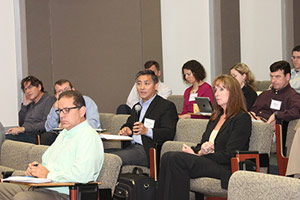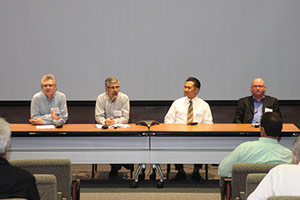 They may be small but they have big appetites, devouring energy 24/7, even when they’re not in use. They’re set-top boxes, those little devices that receive TV satellite and cable signals. And they’re priority number one for the California Plug Load Research Center (CalPlug) housed at Calit2.
They may be small but they have big appetites, devouring energy 24/7, even when they’re not in use. They’re set-top boxes, those little devices that receive TV satellite and cable signals. And they’re priority number one for the California Plug Load Research Center (CalPlug) housed at Calit2.
CalPlug’s second full-day set-top box workshop held last week (the first took place in February) brought together 75 academics, manufacturers, service providers, utility and public agency representatives, and students, who brainstormed energy-saving approaches to device usage. The workshop also touched on other applications for the technology, including home energy-management, security and telemedicine systems.
From power consumption trends and sleep modes to incentive programs and consumer education, attendees spent the day discussing options, sharing ideas and asking questions of each other.
CalPlug is committed to several short-term goals, including characterizing energy consumption in various operational settings, and enabling set-top boxes to hibernate when they’re not in use, waking up within five seconds. “This workshop went a long way toward advancing our goals,” CalPlug Technical Manager Arthur Zhang said. “It’s really helpful to get input from those with experience in different sectors of the industry.”
Welcoming remarks from Calit2 Irvine Director G.P. Li were followed by plenary sessions featuring panels of industry, government and academic experts.
Despite the absence of several East-Coast presenters and participants due to Hurricane Sandy, “the energy level and engagement of stakeholders was very high,” Zhang said.
 The sessions addressed such issues as: Are new technologies, such as “system-on-a-chip,” making set-top boxes more efficient? How can cutting-edge power management technology best be integrated with consumer usage behaviors? What’s the best way to stimulate consumer awareness of incentive programs? Why is it important to establish a set of common terms and labels that apply to energy savings?
The sessions addressed such issues as: Are new technologies, such as “system-on-a-chip,” making set-top boxes more efficient? How can cutting-edge power management technology best be integrated with consumer usage behaviors? What’s the best way to stimulate consumer awareness of incentive programs? Why is it important to establish a set of common terms and labels that apply to energy savings?
Participants then broke into working groups, summarizing their ideas and compiling reports on tangible action items.
“It was extremely productive,” Zhang said. He added that attendees “gave us very encouraging comments,” including two who said CalPlug’s approach “really grasped the most critical aspect of the problem at hand: energy savings and consumer tradeoffs.”
“It was a very successful day,” said Li. “There was a lot of give-and-take from all the participants. I think we will see some productive collaborations and a great deal of progress on several fronts.”
The workshop ended with working demonstrations in the CalPlug Center. Participants viewed the Wall of Power, a simulated living room in which everyday entertainment and household devices teach consumers about real-time energy consumption.
Other demos included the 1kWhr Challenge, the prototyping project room, advances in sleep-mode technology, and a telemedicine application called “Patient Connect,” which uses set-top box protocols to connect hospitalized children with their classrooms.
“Workshops like these are essential to CalPlug’s mission,” Li said. “They help us connect with multiple stakeholders, all of whom bring unique perspectives and years of expertise to our efforts.”
-Anna Lynn Spitzer, 11.07.12
